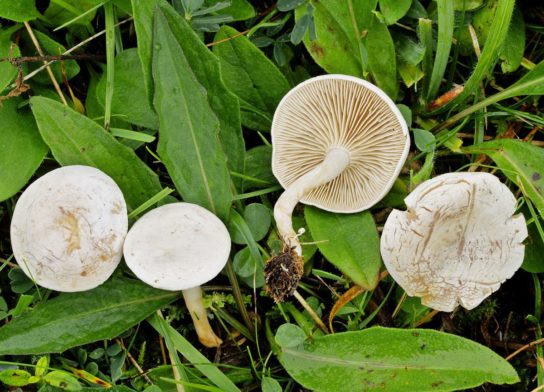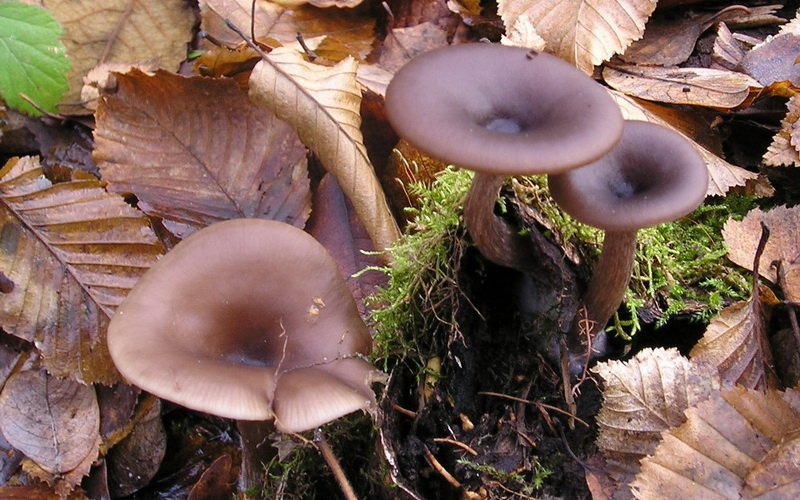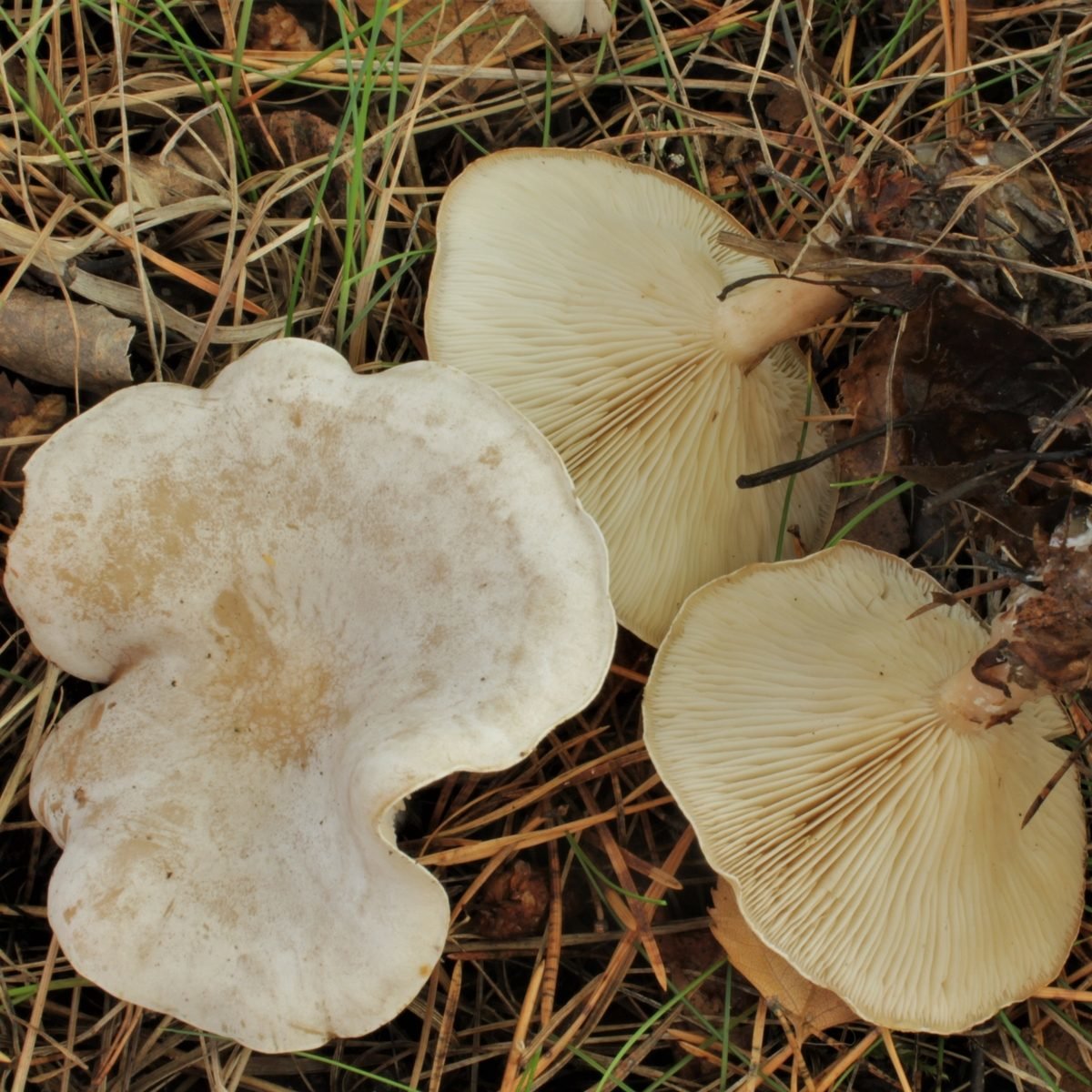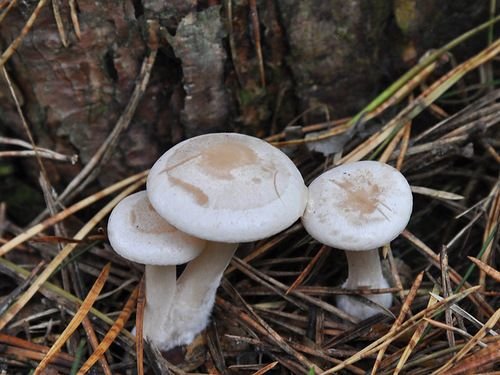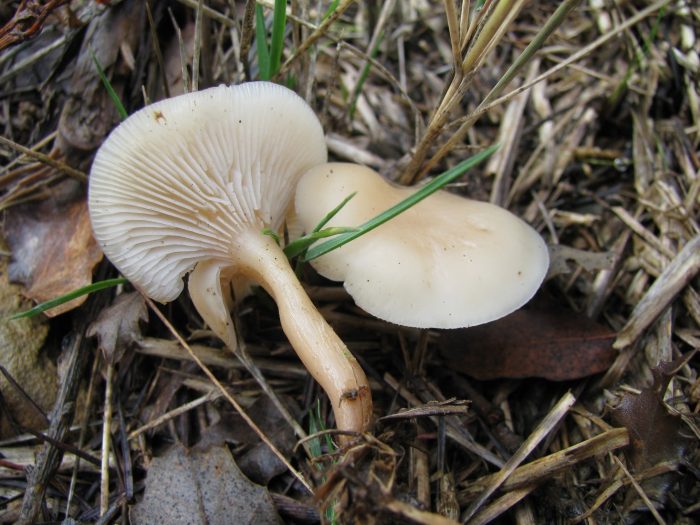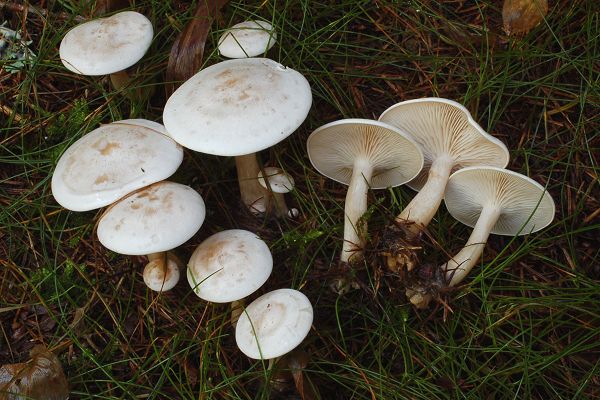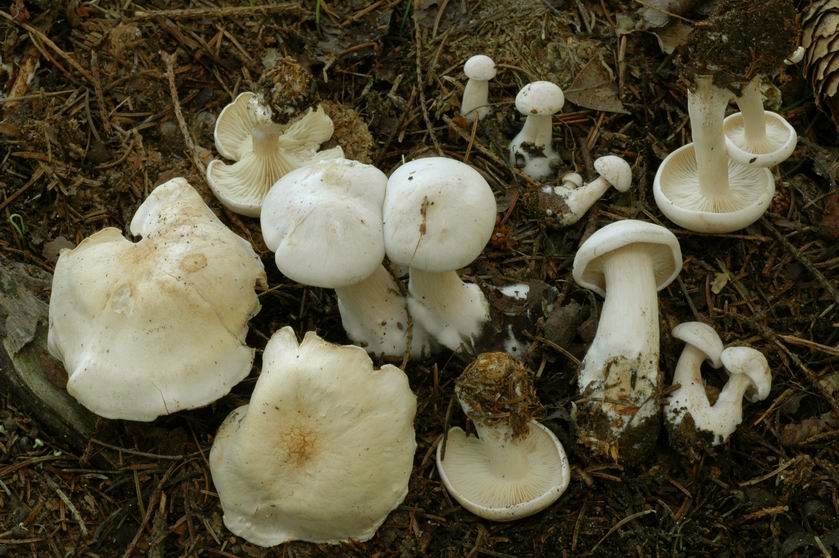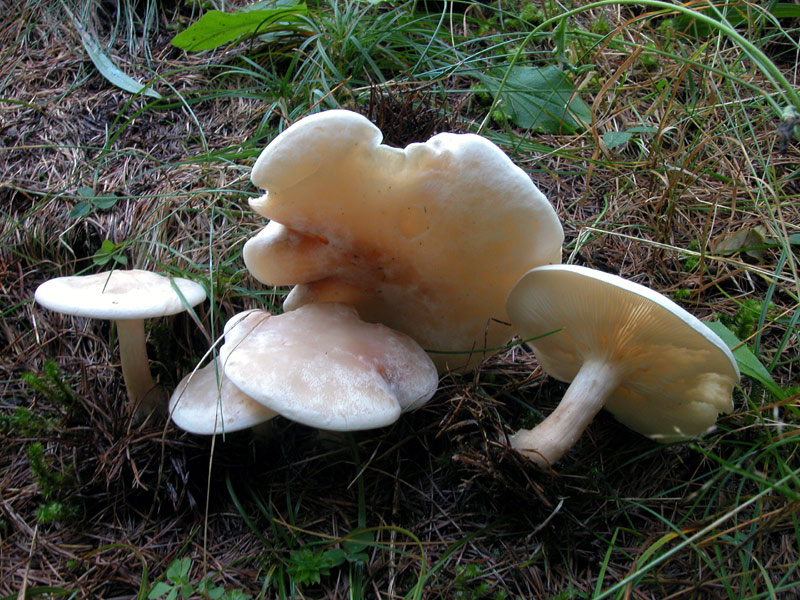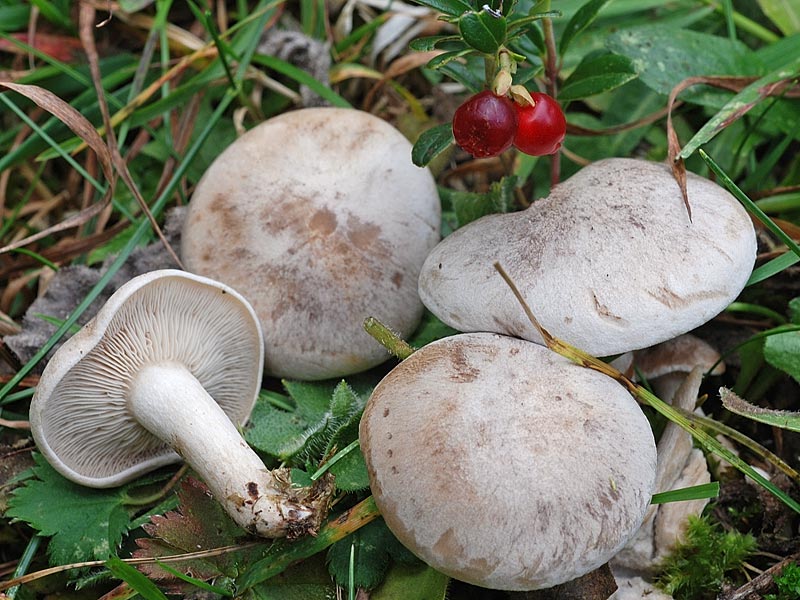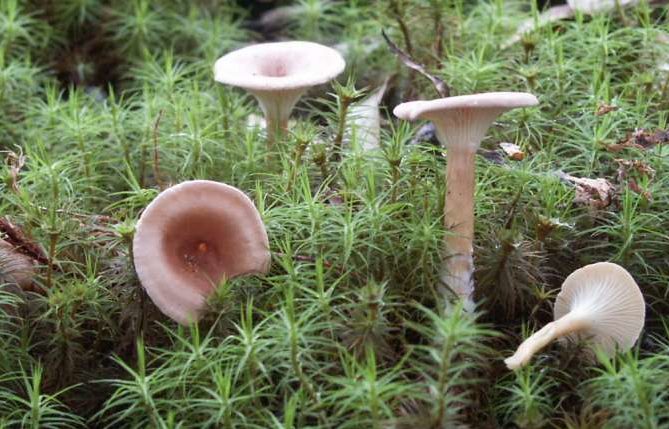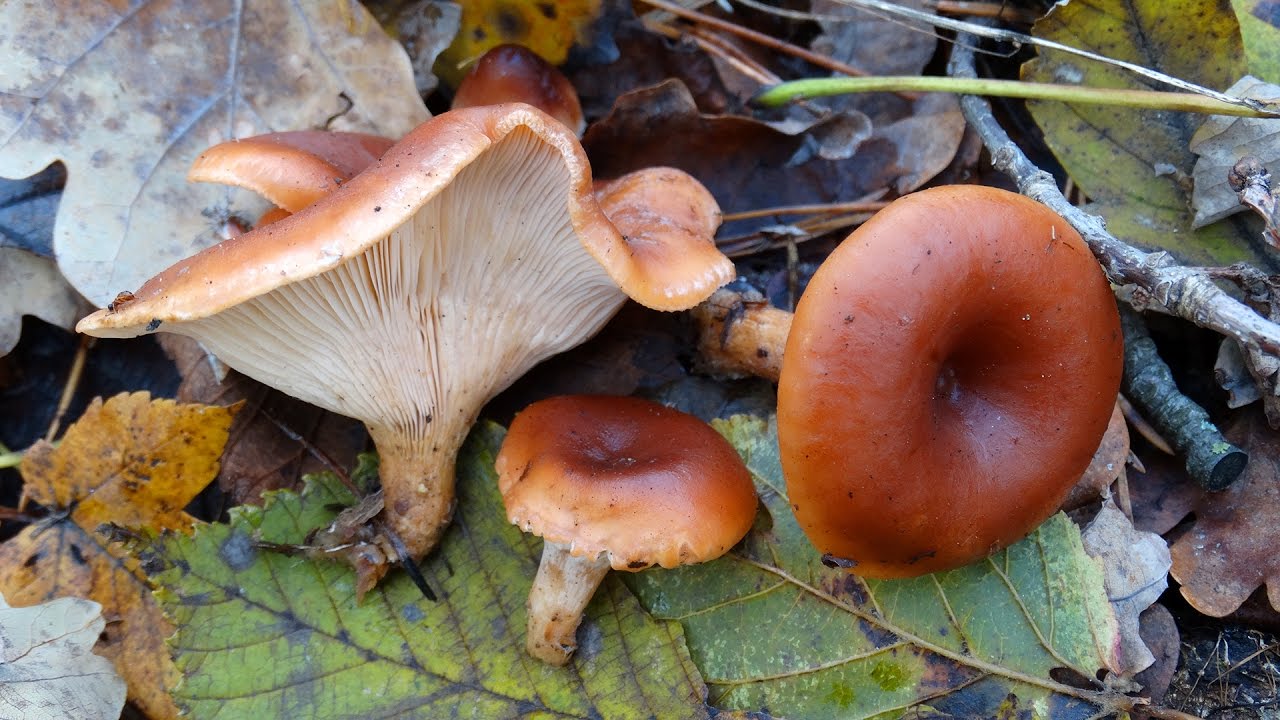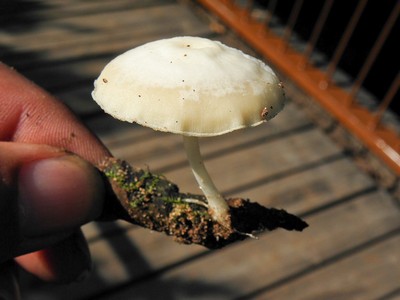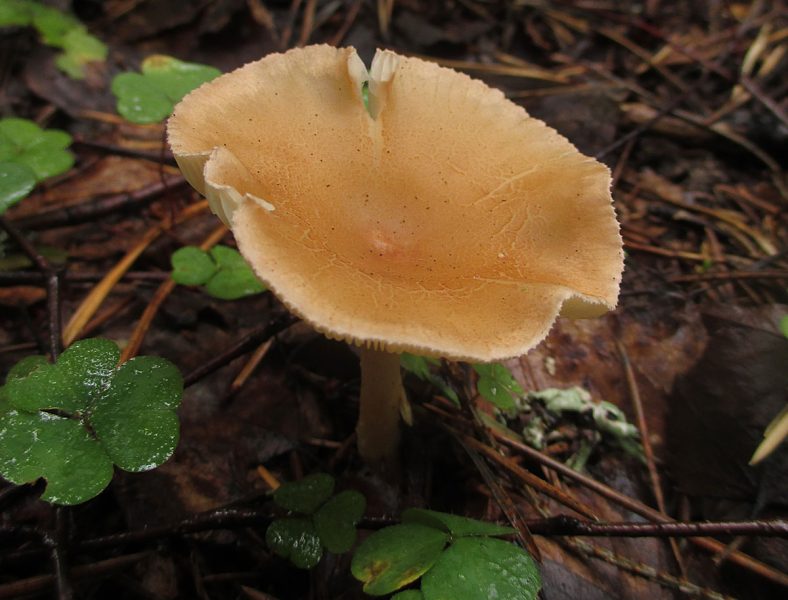Poisonous and inedible species of govorushka mushroom
Whitish or whitish talker (Clitocybe candicans)
Whitish talker is a poisonous mushroom, contains muscarine.
Hat diameter 1-4 cm, the shape of young mushrooms is flat-convex, then becomes flat, depressed, but not funnel-shaped. The surface is covered with a whitish waxy coating, the color is pale grayish or pale reddish. The pulp is grayish-white, watery, strong aroma is similar to the smell of tomato leaves, the taste is bitter, unpleasant. The leg is 2-4 cm long, 0.2-0.4 cm thick, cylindrical, pinkish or grayish-white in color.
Grows in large groups on decaying foliage and needles in deciduous and mixed forests. Occurs in Eurasia and North America from September to mid-October.
Inedible mushroom.
The hat is 3-4 cm in diameter, convex in shape, with a curled edge, smooth, hazel or ocher-reddish in color. Young mushrooms have darker caps. The surface is smooth, shiny, without plaque. The pulp is pale-whitish in color, the taste is soft, the smell is not pronounced. Leg length 2.5-3.5 cm, thickness 0.4-0.6 cm, reddish brown color, cylindrical shape. The surface is dry, matt, bare.
Grows in groups, arcs or rows in pine, rarely in birch forests, the season begins in May and lasts until September. The mushroom is widespread in the Caucasus, Western Siberia, the Far East, Western Europe, North Africa.
Pale-colored talker (Clitocybe metachroa)
Inedible mushroom.
The hat is 3-5 cm in diameter, flat-convex in shape, becomes depressed and funnel-shaped with age, light beige or brownish. Leg length 3-6 cm, thickness 0.4-0.8 cm, pale brown color, cylindrical shape. The flesh is whitish or grayish in color, thin, taste and smell are not expressed.
Inhabits deciduous forests, grows singly or in small groups.
Smoky talker (Clitocybe nebularis)
The diameter of the cap is 5-15 cm, in young mushrooms the shape is hemispherical or convex, the edge is wrapped, in mature mushrooms it is convex-prostrate, the edge is wavy. In wet weather, the cap is gray or yellowish brown; in dry weather it becomes light. The pulp is white, the color does not change on the cut, the structure is fleshy, brittle, dense. The smell and taste are changeable. The leg is 6-10 cm long and 1.5-3 cm thick, dense, clavate.
The mushroom grows in coniferous and mixed forests, in groups, often in circles. The species is widely found in the Northern Hemisphere. The season starts in August and lasts until the end of November.
Smoky talker is considered a mushroom of low quality, it is eaten only after boiling, but it can cause severe digestive upsets.
Leaf-loving talker, waxy, or grayish (Clitocybe phyllophila)
One of the most poisonous mushrooms among talkers.
The cap is 2-9.5 cm in diameter, flat-convex, flattens with age. The color of the cap is whitish or grayish-cream, with spots. The pulp is whitish, with a strong flour, herbaceous or sweetish aroma. The taste is insipid. The leg is 3-7 cm long, 0.5-1.5 cm thick, cylindrical, cream or white.
Grows in large groups, tight rings in forests, on decaying foliage and needles. Occurs throughout Eurasia, from September to late autumn.
Reddish or furrowed talker (Clitocybe rivulosa)
A dangerous poisonous mushroom.
The diameter of the cap is 2-4 cm, the shape is convex, the edge is tucked up, then it becomes prostrate, flat or depressed, with a wavy edge. The color of young mushrooms ranges from powdery white, white-gray and pink-fawn, in old ones - to ocher and pinkish-brown. The surface is covered with a powdery coating. The pulp is fine-fleshy, with an elastic, fibrous structure, white in color, which does not change on the cut. Mushroom flavor; the aroma is sweetish, pleasant. The leg is 2-4 cm long, 0.4-0.8 cm in diameter, cylindrical, white or grayish, with spots.
Grows in small groups in meadows and pastures, forest edges and clearings in deciduous and mixed forests, in parks, in the temperate climatic zone of the Northern Hemisphere.
Inedible and poisonous talkers
Among the talkers come across inedible and deadly mushrooms. And if the former are simply, to put it mildly, useless, the latter can be fatal. Therefore, it does not hurt to find out their description.
Waxy talker
The hat is 3-8 cm in diameter, convex, flat with age, a little later concave, funnel-shaped. The edge is twisted, turned up. The color is whitish, with a gray-cream shade, darker along the edge. Sometimes covered with dirty pink spots. The plates are whitish, creamy with age, dirty yellow in old mushrooms. Quite tight and very narrow, not fitting well. Leg - from whitish to dirty ocher color, cylindrical, sometimes curved. In a young mushroom, it is dense, empty or “wadded” with age. Mycelium grows densely at the base. The pulp is white or off-white, firm, tough. The smell is woody, floral, slightly aniseed. The taste is soft, indefinite. Spore powder - creamy with an orange tint.
It is often found in coniferous and deciduous forests, often under spruces, pines, beeches and oaks, from summer to autumn. Grows in groups on deciduous litter. The fungus is deadly poisonous. Muscarine poisoning.

Waxy talker
The talker is reddish
The hat is 2-5 cm in diameter. At first, it is convex in shape with curled "brims", later it is flat, then a depression is formed in the center, sometimes with a small tubercle at the bottom of the depression. In a young mushroom, it is white, as if covered with frost, later with concentric zones of flesh color, under a layer of frost, as a rule, pale flesh-colored, smooth. Indistinct spots on the cap are very characteristic of this species. The plates are white at first, then off-white, dense, densely arranged, directly fused. They converge quite low on the leg. The leg is 2-4 cm high, 4-6 mm thick, cylindrical, full, slightly fibrous (in the longitudinal direction). Whitish in color with a flesh tint. The pulp is white, elastic, does not change color after being damaged. The taste is vague, the smell resembles freshly ground flour or recently cut wood. The spore powder is white.
Just like the waxy govorushka, it is highly poisonous (muscarinic poisoning). Contains quite a lot of muscarine, a poison that affects the nervous system. Symptoms begin 1/4 to 4 hours after eating. Symptoms: severe sweating, lacrimation, blurred vision, vomiting, colic, gastrointestinal upset. Severe poisoning can lead to death. The fungus is extremely dangerous for people with pulmonary insufficiency or heart disease. The first symptoms of poisoning appear within 15-30 minutes after eating the mushrooms, and often disappear after 2 hours. Atropine is used as an antidote.

The talker is reddish
Cupped talker
The cap is 3-4 cm in diameter, initially convex, white, whitish or creamy, later flat, then concave, less often funnel-shaped. On the edge, the mushroom is lamellar-transparent. The plates are white, later creamy, non-accrete, poorly matching in old fruiting bodies, narrow, thin, thick. The leg is whitish, cylindrical, slender, relatively long, sometimes narrowed at the base, full. The flesh is white, thin, aroma of flour, although sometimes described as the smell of a dirty rag. Spore dust - white, creamy.
Also read: Edible and inedible mushrooms of the Krasnodar Territory
It grows from September to November in dry meadows, pastures, on the edge of the forest, along roads, sometimes also in gardens. The mushroom is considered poisonous, although according to some sources it is simply inedible.
Species that look like a waxy talker
May's row (Calocybe gambosa) has a denser flesh and a powdery odor, found in similar habitats, but mainly between late April and early July.

May row
Taxonomic history
The waxy gossip was described in 1801 by Christian Hendrik Person, who gave the binomial scientific name Agaricus phyllophilus.(At that time, most of the gill fungi were placed in the giant genus Agaricus, which has since been revised and most of its contents have been transferred to other new genera.)
In 1871, the German mycologist Paul Kummer transferred this species to the genus Clitocybe, giving it a common scientific name.
Red-brown talker (Paralepista flaccida)
Synonyms:
- Red & brown talker
- Clitocybe flaccida
- Omphalia flaccida
- Lepista flaccida
- Clitocybe infundibuliformis sensu auct.
- Clitocybe inversa
- Omphalia inversa
- Lepista inversa
- Clitocybe gilva var. guttatomarmorata
- Clitocybe gilva var. tianschanica
Description
Hat with a diameter of 3-11 cm (sometimes up to 14 cm); at first it is convex with the edges tucked inward, with age it straightens out to a flat one or even takes the form of a shallow funnel or bowl; its surface is dry, almost smooth, matte, orange-brown or brick-colored; hygrophane (turns pale when dry). The edge of the cap is often wavy, with pronounced depressions such as the spout of a jug, which distinguishes this species from the similar funnel-shaped talker (Clitocybe gibba). There is evidence that sometimes in inverted talkers, which appear already very late in the fall, the cap remains convex, without forming the usual depression in the center.
The plates are descending, narrow, rather frequent, at first almost white, later pinkish-beige or pale orange, with age they become dark orange or pink-brown.
Leg 3-10 cm in height and up to 1.5 cm in diameter, more or less cylindrical, dry, finely pubescent; painted to match the cap, only slightly lighter; pubescent of whitish mycelium at the base.
The pulp is thin (in the cap), whitish, with a sweetish odor, which is sometimes compared to the smell of frozen orange juice or bergamot, without a pronounced taste.
Whitish to off-white spore mark Spores 4-5 x 3.5-4 μm, practically spherical to broadly elliptical, finely warty, non-amyloid. Cystyds are absent. Buckled hyphae.
Chemical reactions
KOH paints the surface of the cap yellow.
Ecology and distribution
Saprophyte, grows scattered or in close groups on a coniferous litter, often at the foot of anthills, sometimes on wet sawdust and wood chips. More often found in coniferous and mixed forests, sometimes it grows on humus-rich soils, where it forms spectacular "witch rings". A common species in the Northern Hemisphere, common in North America, mainland Europe and Great Britain. The period of active growth is autumn, until the onset of cold weather, however, in some places it can shift to winter (for example, the coast of California), or continue - in mild climates - until January (for example, in Great Britain and Ireland).
What can be confused with an inverted talker
The funnel-shaped talker (Clitocybe gibba) found in the same biotopes is distinguished by a paler coloration, the absence of a wavy edge, and significantly larger, elongated white spores. In addition, it has a much thicker flesh in the cap. The brown-yellow bell (Paralepista gilva) has a lighter, creamy yellow or brownish-yellow hue, and the cap shows rounded watery spots (in youth) or dark rusty brown specks (in more mature specimens).
The much larger Lepista multiformis is found in open grassy areas (meadows, roadsides, parks and lawns), and has been recorded in Europe (rather rare).
Edibility
According to some sources, Red & brown talker not poisonous, but its nutritional quality leaves much to be desired, and it makes little sense to collect it.
According to others, it is poisonous (contains muscarinic toxins).
Video about the Ginger-brown mushroom:
Beneficial features
Rows have a whole list of useful properties. So, for medicine, it is very valuable that many antibiotics are obtained from the enzymes contained in the rows, which are most often aimed at combating the tubercle bacillus. Also, mushrooms are rich in vitamins of group B, PP, C, A.
These mushrooms are known to help well with mental fatigue.Doctors recommend ryadovki for people suffering from diabetes and hypertension.
Due to the fact that mushrooms are very low in calories, they are excellent for dietary nutrition, and the presence of a large amount of trace elements and proteins makes them an excellent food for vegetarians. In terms of their chemical composition, they are very close to meat, therefore they are able to completely replace it.
Edible mushrooms are very useful for humans. Their benefit lies in the fact that mushrooms contain vitamins and substances that have a beneficial effect on the body, helping to cope with many diseases.
Thanks to scientific research and chemical analysis of the mushroom, it was found that the rows have the following properties:
- antibacterial;
- antioxidant;
- immunomodulatory;
- antiviral;
- anti-inflammatory.
In addition, the use of row mushrooms is based on the fact that the use of this product contributes to:
- removing toxins from the body;
- normalization of the tone of the stomach and intestines;
- regeneration of liver cells.
It can be concluded that the described ryadovka mushrooms (only edible) should be included in the diet for people with diabetes mellitus, oncology, arrhythmia, diseases of the genitourinary system, rheumatism, nervous disorders and osteoporosis.

Leafy talker (Clitocybe phyllophila)
- Other names for the mushroom:
- Waxy talker
- Leaf-loving talker
Synonyms:
- Waxy talker
- Greyish talker
- Lepista phyllophila
- Clitocybe pseudonebularis
- Clitocybe cerussata
- Clitocybe difformis
- Clitocybe obtexta
- Clitocybe dilatata
- Clitocybe pithyophila
Description
A hat with a diameter of 5-11 cm, in youth it is convex with a tubercle and a marginal zone tucked inward; later flat, with a turned-up edge and a barely noticeable elevation in the center; and, ultimately, funnel-shaped with a wavy edge; marginal zone without radial banding (i.e., the plates do not shine through the cap under any conditions); unhygropic. The cap is covered with a white waxy layer, under which the surface of a flesh-colored or brownish shade, sometimes with ocher spots, shines through; in the marginal zone of older fruiting bodies, watery spots are visible. Sometimes this waxy coating cracks to form a "marble" surface. The peel from the cap is removed to the very center.
The plates are adherent or slightly descending, with additional plates, 5 mm wide, not very frequent - but also not very rare, about 6 plates per 5 mm in the middle part of the radius, covering the lower surface of the cap, extremely rarely bifurcating, at first white, later ocher -cream. The spore powder is not pure white, but rather a dirty flesh-colored or pinkish-cream shade.
Stem 5-8 cm high and 1-2 cm thick, cylindrical or flattened, often slightly widened at the base, less often tapering, at first white, later dirty-ocher. The surface is longitudinally fibrous, in the upper part it is covered with silky hairs and a whitish “frosty” coating, at the base with woolly mycelium and a ball of mycelium and litter components.
The flesh in the cap is thin, 1-2 mm thick, spongy, soft, white; stiff in the stalk, pale ocher. The taste is soft, with an astringent aftertaste. The smell is spicy, strong, not quite mushroomy, but pleasant.
Spores often stick together in two or four, size (4) 4.5-5.5 (6) x (2.6) 3-4 microns, colorless, hyaline, smooth, ellipsoid or ovoid, cyanophilic. Hyphae of the cortical layer 1.5-3.5 µm thick, in deeper layers up to 6 µm, septa with buckles.
Ecology and distribution
Deciduous govorushka grows in forests, more often on deciduous litter, sometimes on coniferous (spruce, pine), in groups. Active fruiting season from September to late autumn. It is a species common in the northern temperate zone and is found in mainland Europe, Great Britain and North America.
Poisoning symptoms
Before the first symptoms of poisoning appear, it takes from half an hour to 2-6 hours. Begins nausea, vomiting, diarrhea, abdominal pain, profuse sweating, sometimes drooling, pupils constrict.In more severe cases, severe shortness of breath appears, the secretion of bronchial secretions increases, blood pressure drops and the pulse decreases. The victim is either agitated or depressed. Dizziness, confusion, delirium, hallucinations and, ultimately, coma develop. Mortality occurs in 2-3% of cases and occurs after 6-12 hours with large quantities of eaten mushroom. Fatalities are rare among healthy people, but for people with heart and respiratory problems, as well as for the elderly and children, it is a serious danger.
We remind you: at the first symptoms of poisoning, you should immediately consult a doctor!
How to distinguish a deciduous talker from other mushrooms
Under certain conditions, a conditionally edible saucer-shaped govorushka (Clitocybe catinus) can be taken for a deciduous gossip, but the latter has a matte surface of the cap and more descending plates. In addition, the saucer-shaped spores are of a different shape and larger, 7-8.5 x 5-6 microns.
The bent beetle (Clitocybe geotropa) is usually twice as large, and its cap has a pronounced tubercle, so it is usually quite easy to distinguish between these two species. Well, the spores of the bent talker are somewhat larger, 6-8.5 x 4-6 microns.
It is much more unpleasant to confuse edible sub-cherry (Clitopilus prunulus) with a vernacular gossip, but it has a strong flour smell (for some, however, quite unpleasant, reminiscent of the smell of spoiled flour, forest bugs or overgrown cilantro), and pinkish plates in mature mushrooms are easily separated from the cap with a fingernail. In addition, the spores are larger in the sub-cherry.
How to cook soup with talkers
Products Fresh talkers - 500 grams Carrots - 1 piece Parsley - 3 stalks Zucchini - 300 grams Tomato - 2 pieces Green onions - 20 grams Potatoes - 4 piecesTalker Soup Recipe 1. Clean, rinse, cut the talkers. 2. Cook the talkers in water with the addition of salt. 3. Wash the celery, peel and chop the carrots. 4. Wash, peel and cut the potatoes into 1 centimeter cubes. 5. Fry carrots, tomatoes and celery in sunflower oil. 6. Add carrots to govorushkovy soup along with green onions. 7. Boil the talkative soup for 10 minutes.Serve talker soup with sour cream.Author / editor - Lidia Ivanova Reading time - 5 minutes. How much to cook ›Mushrooms› Talkers
Who can be confused with the poisonous Talker

This mushroom has a close relative. Bleached Clitocybe rivulosa - the same poisonous muscarinic mushroom, which also cannot be collected. It is much more dangerous to confuse the Voskovataya Talker with edible mushrooms:
Sub-cherry Edible Clitopilus Prunulus - very similar in appearance to a poisonous talker, but has a characteristic smell of spoiled flour.

Talker Bent Clitocybe Geotropa - similar, but twice its size, and on the cap it has a pronounced tubercle.

Saucer-shaped talker Clitocybe Catinus - has a matte surface of the cap and more descending plates.

Like all creations of nature, Govorushka Voskovataya has its place in the cycle of life, but for the sake of his own safety, it is better for a person to bypass it.

